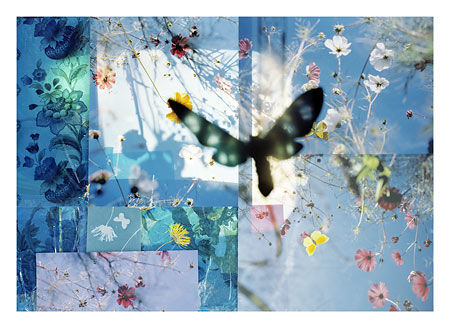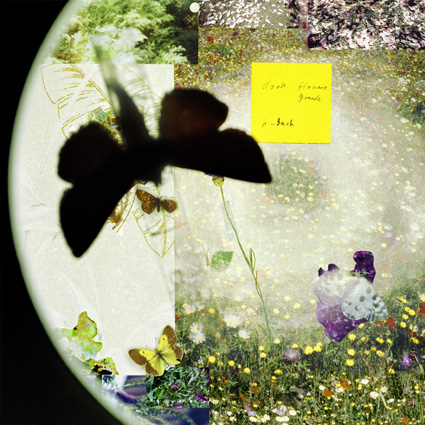I saved an Admiral’s life
2009-10
„butterflies – I saved an Admiral’s life“, 2009/10
Lambda-Prints mounted on aludibond with Diasec-Plexiglas,
119 x 159 cm, 119 x 119 cm, 75 x 100 cm; Edition 5 + 1 a.e.
During my childhood I caught a lot of butterflies for my father’s entomologic collection. In that time it was fun and I got paid with love and money.
Later in my adolescence I’ve asked myself several times whether the butterflies’ death caused by hydrogen cyanide vapours or pyroligneous acid ether was as absolutely painless as my father always assured me. As a young grown-up I’ve long ago lost interest in collecting and skewering small beautiful dead animals; and due to my changed consciousness I knew that I’ve had killed thousands living beings.
Cultural-historically butterflies are applied to the sign of a soul freed from the body: in old Greece the term “psyche” (literally: breath, soul) was in use to denominate the insect; hence on visual representations of a deceased person the soul appeared as featured by a butterfly’s wing.
Also christian iconography (e.g. on some grave stones from the romanticism period) interpreted the butterfly as a ressurection symbol, particularly because of the characteristic metamorphism which every single animal has to transform in its morphological evolution. Passing through the rather shabby phases of egg, nymph, larva, cocoon it arrives at the imago: it is in this last state of manifestation where the individual literally becomes an image.
Some day during a forest walk I had the chance to save a single Admiral-lepidopteran from drowning in a pond; comletely dressed I waded into the water to save this single butterfly.
This incidence was very important for me: it felt as if the rescue of the single one had balanced the killing of the many other butterlies.
As a kind of artistic rehabilitation I compiled analog picture assemblages and collages from self-photographed butterflies, old butterflies’ photographs from my father, nature motifs from wallpapers’ floral patterns, real dead butterflies, pressed flowers etc. and photographed these assemblages with a large-format camera. For the staging of the bellows camera these two-dimensional picture constallations have been expanded spacially and temporally.
Spacially Backwards: on the collages’ rear side “floating” butterflies were adhered and backlit with light from the realm of the dead into the picture procedure…
Spacially Forwards: into the bellows of the large format camera I’ve glued moths and flowers (where they are usually looking for nectar), where they blacken the film negative and in terms of composition photogram-like outline and shape the motif.
Temporally: dead butterflies hanging on nylon threads get re-animated by stroboscope flashes and become motion-blurred with the allover composition.
The trompe l’oeuil-effect of the large formated and colorful prints faces the observer with an exuberant nature literally oozing out the picture creating oscillation figures regarding content and form, thus thwarting the technical manner of the medium of photography.
For me the work “butterflies – I saved an Admiral’s life” is a symbolic and artistic reanimation transcending the butterflies’ thematic motif dealing with the fact of the balance of Eros and Thanatos.
„butterflies – dem admiral das leben gerettet“, Ausstellungsansicht Einzelausstellung Galerie Obrist, Essen 2010




„butterflies – dem admiral das leben gerettet“, Ansicht innerhalb der Gruppenausstellung „Szene Rhein-Ruhr“ in der Galerie Klose, Würzburg 2010

„butterflies – dem admiral das leben gerettet“, 2009/10
In meiner Kindheit habe ich sehr viele Schmetterlinge für die entomologische Sammlung meines Vaters gefangen. Ich habe Geld und Liebe dafür bekommen und es hat mir damals Spaß gemacht.
Später in meiner Jugend habe ich mich dann doch öfters gefragt, ob der Tod der Falter durch Blausäuredämpfe und Holzessigäther wohl wirklich so absolut schmerzlos und sorgenfrei war, wie mir mein Vater immer wieder versicherte. Als junger Erwachsener hatte ich längst das Interesse an Schmetterlingssammlung, Spannbrettern und dem damit verbundenen Aufpieksen von kleinen toten Tieren verloren; und mein verändertes Bewusstsein sagte mir, dass ich Tausende von Lebewesen getötet hatte (um der Liebe des Vaters willen).
Kulturgeschichtlich kann man aufzeigen, dass Schmetterlinge als Zeichen der aus dem Körper befreiten Seele gelten: im alten Griechenland wurde das Wort (psyche) (wörtlich: Hauch, Atem, Seele) auch als Bezeichnung für das Insekt benutzt; folglich erschien auf bildlichen Darstellungen die Seele eines Verstorbenen häufig mit Schmetterlingsflügeln ausgestattet.
Auch die christliche Ikonographie sah (z.B. auf einigen Grabsteinen aus der Zeit der Romantik) im Schmetterling ein Auferstehungssymbol, vor allem wegen der charakteristischen Metamorphose (Verwandlung), die jedes einzelne Tier in seiner morphologischen Entwicklung durchläuft. Über die eher unansehnlichen Stadien von Ei, Nymphe, Larve und Puppe gelangt es zur Imago: in diesem letzten Stadium wird die eigentliche Erscheinungsform des Individuums buchstäblich Bild.
Irgendwann während eines Waldspaziergangs hatte ich dann die Möglichkeit, einen einzelnen Admiral-Schmetterling vor dem Ertrinken zu retten; mit kompletter Kleidungsmontur bin ich ins Wasser gewatet, um diesen einzelnen Schmetterling zu retten. Dieses Ereignis war extrem wichtig für mich: es fühlte sich an, als ob ich durch die Rettung dieses einzelnen das Töten der vielen anderen Schmetterlinge ausbalanciert hätte.
Als künstlerische Aufarbeitung dieses Moments erstellte ich analoge Bild-Assemblagen und –Collagen aus selbst fotografierten Schmetterlingen, alten Schmetterlingsfotos meines Vaters, Naturmotiven aus Tapetenbüchern mit floralen Mustern, echten toten Schmetterlingen, gepressten Blumen etc. und reproduzierte diese Assemblagen dann im großen Format.
Diese zweidimensionalen Bildkonstellationen wurden für die Inszenierung mit der Grossbild- Balgenkamera räumlich und zeitlich erweitert.
Räumlich nach hinten: auf der Rückseite der Bildcollagen kleben und „fliegen“ Schmetterlinge und werden von hinten aus dem Totenreich durch Licht wieder ins Bildgeschehen eingeleuchtet…
Räumlich nach vorne: im Balgen der Grossbildkamera habe ich noch Falter und Blumen (auf denen sie normalerweise nach Nektar suchen…) in den Balgen eingeklebt, so dass sie die Lichtstrahlen, die eigentlich den Film belichten sollen, mit schwarzen figurativen Umrissen als Fotogramm-ebene kompositorisch mit definieren
Zeitlich: an Nylonfäden hängende tote Schmetterlinge werden durch stroboskopische Blitze fotografisch re-animiert und verschwimmen bewegungsunscharf mit der allover-Komposition.
Der trompe l’oeuil-Effekt der grossformatigen und farbintensiven Abzügen konfrontiert den Betrachter mit formalen und inhaltlichen Oszillationsfiguren einer überbordenden Natur, die förmlich aus dem Bild herausquillt, und damit den technischen Gestus des Mediums Fotografie konterkariert.
Die Arbeit „butterflies – dem Admiral das Leben gerettet“ ist für mich eine symbolische Re-Animation, eine künstlerische Wiederbelebung, die weit über das Motiv der Schmetterlinge hinausgeht und sich mit der Tatsache der Ausbalancierung von Eros und Thanatos auseinandersetzt.
„butterflies – I saved an Admiral’s life“, installation views, solo exhibition at Gallery van Kranendonk, The Hague 2011





„butterflies – I saved an Admiral’s life“, installation views, artist commission for the townhall of the city of Leiderdorp, The Netherlands 2012
















